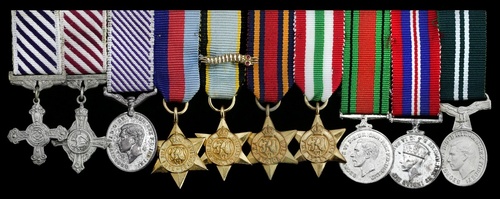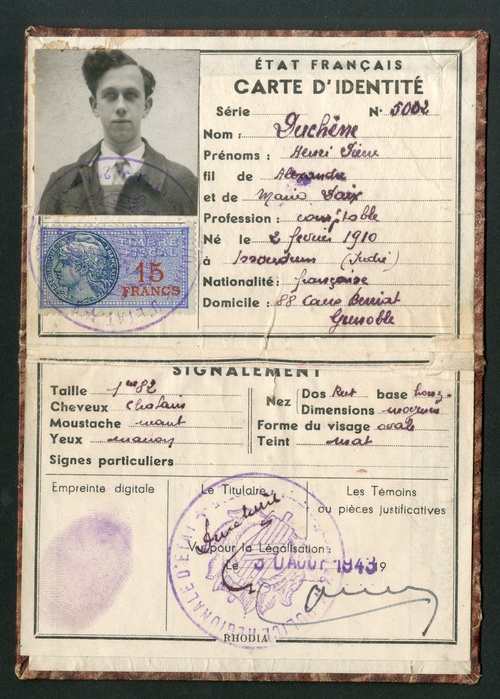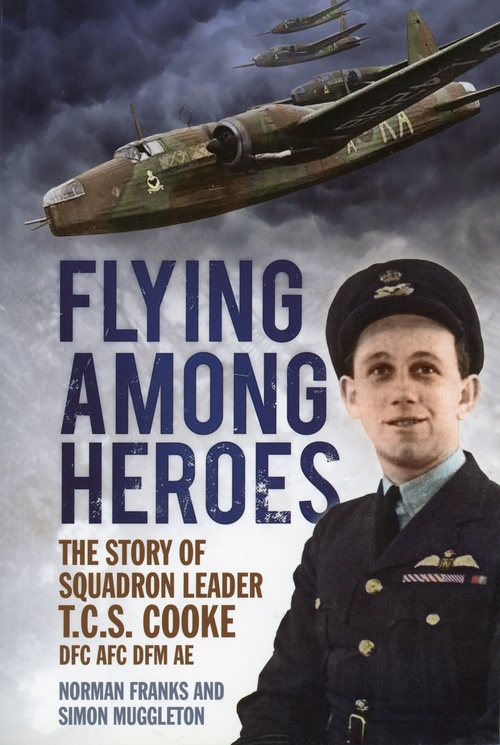Auction: 18001 - Orders, Decorations and Medals
Lot: 43
'I went down to get out of the lower escape hatch but found it was jammed, so came back to the cockpit and looking out I could see we were in a spiral and decided to try and fly the aircraft down. However, the wing then became a mass of flames and the altimeter was spinning round, so I struggled back down to the hatch and managed to beat it open, and baled out … '
Squadron Leader T. C. S. Cooke recounts the hair-raising moment that led to his membership of the Caterpillar Club.
The outstanding mounted group of ten miniature dress medals and the Caterpillar Club membership badge worn by Squadron Leader T. C. S. Cooke, D.F.C., A.F.C., D.F.M., Royal Air Force, together with his original Flying Log Books and a substantial archive
The remarkable story of Cooke's wartime career - comprising three action-packed operational tours and 63 sorties - is retold in the pages of Flying Among Heroes, a career that was finally curtailed on the night of 7-8 February 1943, when his Halifax of 138 (Special Duties) Squadron was hit by flak whilst delivering an S.O.E. agent to France
The agent in question was Francis Cammaerts, D.S.O. - a.k.a. 'Roger' - and he moved swiftly to round-up Cooke and his crew after the whole had baled out of their stricken aircraft: in fact he put them in touch with a local Resistance group who set in motion their successful evasion to Gibraltar
Distinguished Flying Cross, G.VI.R.; Air Force Cross, G.VI.R.; Distinguished Flying Medal, G.VI.R.; 1939-45 Star; Air Crew Europe Star; Africa Star; Italy Star; Defence and War Medals 1939-45; Air Efficiency Award, G.VI.R., mounted as worn, together with the recipient's Caterpillar Club membership badge, gold with 'ruby' eyes, by Irvin Air Chute Company, the reverse engraved, 'S./L. T. C. Cooke, D.F.C., A.F.C., D.F.M.', and related membership card, good very fine (10)
Thomas Charles Seymour Cooke was born in Southsea, Portsmouth, on 23 July 1921, the only son of Mr. and Mrs. Herbert Seymour Cooke, previously of Heston's Post Office, Alconbury. Educated at St John's College, Southsea, he left full-time education in 1938 and became a junior clerk in the Portsmouth Rates and Electricity Department. As photographs of him clearly show, he had a passion for model aircraft and flying and with this in mind he enlisted in the Royal Air Force Volunteer Reserve in August 1939:
'I have to say I was delighted when the declaration of war came. I'd been interested in aircraft since the age of seven and people like Billy Bishop, von Richthofen, Roy Brown, etc., were extremely well known to me. Thus, with my interest in flying, I had a burning desire to emulate such men, so when war broke out, like all my fellow reservists down at Portsmouth, we were all very interested.'
1st tour: 78 and 104 Squadrons
However, whilst Cooke harboured ambitions of becoming a fighter pilot, the R.A.F. had other plans for him, namely to be a bomber pilot. He was posted to No. 31 Training Wing and thence to No. 78 Squadron, a Whitley unit operating out of R.A.F. Dishforth. He later described his first sortie:
'My very first raid was on Berlin. As far as I recall it was a maximum effort that night and I remember we were briefed to go over the target separately in order to create the impression of a larger force than we were. In addition to that, we used to throw empty beer bottles out because they would make a screaming noise as they went down. All part of the psychological ideas put forward to upset the Germans.'
Cooke's log books go on to record 18 further sorties in No. 78 Squadron, many with night-fighter attacks and references to the firestorms created within the German industrial targets; his final operation with 78 Squadron was an attack on the French port of Brest on 30-31 March 1941, this time the targets being the Scharnhorst, Gneisenau and Prinz Eugen.
In May 1941, Cooke transferred to No. 104 Squadron, a Wellington unit, and it was in this capacity that he flew eight further sorties to complete his tour.
Awarded the D.F.M. and commissioned Pilot Officer, his subsequent period of 'rest' at No. 22 O.T.U. was interrupted by the onset of Bomber Command's '1000 Bomber Raids' in May-June 1942: he flew to Cologne and Essen in the same period, his flying log book entry for the latter raid noting: 'Attacked by fighter over the Dutch coast, six quarter attacks starboard and port.' Later in the year, on the night of 13-14 September, he was ordered to Bremen: 'Flak intense and accurate. Aircraft hit 36 times. Fuel pipes severed and emergency procedure adopted.'
He was awarded the A.F.C.
2nd tour: 15 and 214 Squadrons
In November 1942, Cooke commenced his second operational tour as a recently promoted Flying Officer in Stirlings of No. 15 Squadron. Half a dozen sorties ensued, to France and Italy, in addition to such targets as Stuttgart and Stettin, following which he transferred to No. 214 Squadron.
He subsequently flew 14 further sorties in the period leading up to March 1943, among them a brace of trips to the 'Big City'. He was awarded the D.F.C., the recommendation noting his earlier part in the '1000 Bomber Raids' and encounters with enemy night fighters.
3rd tour: 138 (Special Duties) Squadron
By September 1943, Cooke was itching to get back into action and he made a successful application to join No. 138 (Special Duties) Squadron at R.A.F. Tempsford. Judging by the following entry in his Flying Log Book - dated 13 August 1943 - he had earlier attempted to join No. 617 Squadron: 'To Scampton to see W./C. Gibson, V.C., D.S.O., D.F.C., and S./L. Holden, D.S.O., D.F.C.'
He was advanced to the acting rank of Squadron Leader and, piloting the unit's Halifaxes, flew a flurry of missions to Belgium, France, Norway and Poland, on one occasion embarking an S.O.E. agent attired in German uniform.
On his thirteenth such sortie, however - to France on the night of 7-8 February 1944 - the bad penny finally turned up. On that date he was charged with delivering Francis Cammaerts - a.k.a. 'Roger' - to S.O.E's 'Donkeyman' circuit but his Halifax sustained flak damage on crossing the coast. Notwithstanding the resultant damage, and worsening weather, he continued his mission, flying low towards southern France. As he neared the intended D.Z. a serious fire developed in one engine, sufficiently serious for Cooke to give the order to abandon the Halifax. All took to parachutes.
Cooke landed in a snow-bound area, a few miles north of Valence and, as related, fell into the welcome hands of the Resistance. After further adventures related in Flying Among Heroes, he crossed the Pyrenees into Spain, and journeyed thence to Gibraltar and freedom. But his recent experiences had taken their toll and he saw no further operational service:
'I was in hospital on D-Day, having ruptured myself when baling out, so I had to have it sewn up. Also my feet were in quite bad shape.'
Cooke was posted to the Air Ministry on desk duty to recuperate but he would fly again in post-war years. He was one of only five Royal Air Force officers to receive the combination of decorations described above.
Sold with an impressive and rare array of original documentation, photographs and ephemera, including:
(i)
The recipient's R.A.F. Pilot's Flying Log Books (2), covering the periods December 1939 to August 1942, and August 1942 until March 1950; the latter includes flights in Catalinas and Dakotas in South-East Asia in 1945-50 and has a closing statement 'Transferred to Log Book No. 3', this being the point in time that Cooke ended his R.A.F. flying career to pursue a new career as a civilian airline pilot.
(ii)
An outstanding photograph album, titled 'Bomber Pilot, 1939-1945,' the first half upbeat and including images of Cooke as a young man with a passion for model aircraft, a Tiger Moth - possibly one in which he trained - photographs with his contemporaries, and a host of images of his crews and bomber aircraft flown; the photographs are all carefully annotated, include two images of the King and Queen visiting 138 Squadron and, with the addition of assorted added newspaper cuttings, offer a fascinating insight to his life. Mid-way through, the album is headed 'Time runs out, February 1944' and includes an original telegram to Mrs. J. Cooke, informing her that her son is missing in action, followed by another - happier - message two months later, informing his mother that he had arrived in Gibraltar; included is a copy of a portrait photograph titled 'Home, but rather frayed around the edges' and his original evasion 'Carte d'Itentite'. The album concludes with a portrait photograph of Cooke as a pilot on leaving British European Airways, together with two photographs of him in company with the Her Majesty the Queen Mother at the unveiling of the 'Bomber' Harris's statue in London; together with approximately 30 further loose photographs of him during the war.
(iii)
Medal entitlement slip and Air Ministry letter of thanks for his war service; and his Royal Air Force Escaping Society membership card, dated 1950, number 791.
(iv)
A substantial modern file containing research and clippings relating to Cooke and other members of his crew, notably 'Reg' Lewis, D.F.C., who was a navigator on many of Cooke's clandestine missions over France. His accounts offer an excellent insight into what happened when the crew were forced to take to their parachutes over France; also included is a hand-written account of a recorded interview with Cooke, held by the sound archive of the Imperial War Museum, together with an account written by his nephew to Simon Muggleton, praising the author's book and offering a few more personal insights into his life; further substantial research includes recommendations for awards and individual missions, each meticulously ordered and used for the biography on Cooke.
Subject to 20% VAT on Buyer’s Premium. For more information please view Terms and Conditions for Buyers.
Sold for
£1,400









